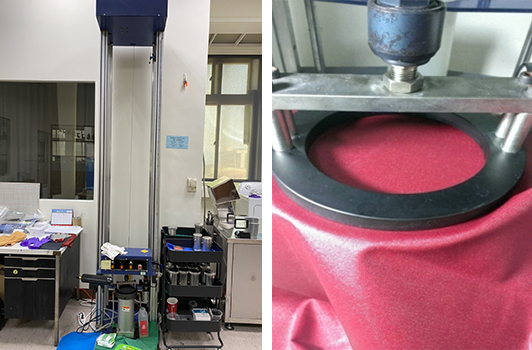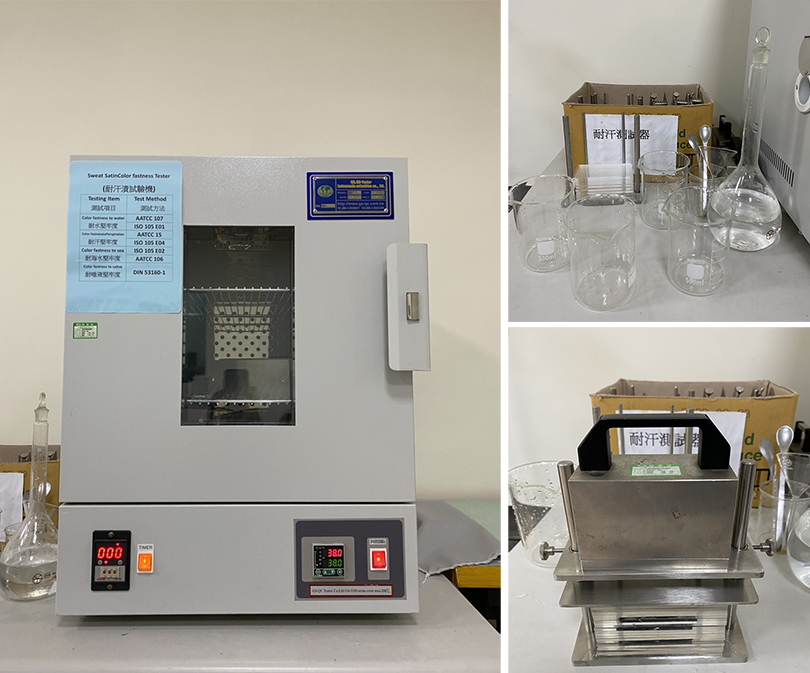2022.12.14How to Maintain Textiles Quality Through Professional Inspections?

How will you know if your textiles are waterproof? water repellent? colorfastness? washable? abrasion resistant? stretchable?
During the R&D and even the pre-shipment, to ensure that the products meet the specifications and safety standards that were agreed upon, Inspection is indispensable! In order to test the fabrics, it's often necessary to send them to a third-party inspection. But Honmyue provides a one-stop service. To ensure the quality of per order, We set up a completely constant temperature and humidity laboratory and employs professionally trained testers to provide the customer with different test items and report.

Q: What is Tensile Strength mean?
A: it's defined as the maximum stress that a material can withstand when it is allowed to be stretched or pulled without breaking(release the stress and the fabric can return to its original shape)
What Tensile Strength test method can we provide? (by Universal Testing Machine)
- ASTM D5034
- ASTM D5035
- ISO 13934-2
Q: What is Tearing Strength mean?
A: It's defined as the force required to start to tear a fabric, on both sides (warp and weft) separately. Test for the tear growth of fabric, not the breaking point. Also termed as tearing resistance of the fabric.
What Tearing Strength test method can we provide? (by Universal Testing Machine and Falling-Pendulum Machine)
- ASTM D2261
- ASTM D4704
- ASTM D1424 > the most popular test method
- ISO 13937-2
- ISO 13937-3
- ISO 13937-4
Q: What is Seam Strength mean?
A: It should be equal to or a little bit lower than the strength of the fabric, ensure fabric may not be break due to unexpected force to the fabric.
What Seam Strength test method can we provide? (by Universal Testing Machine)
- ASTM D434

Q: What is Hydrostatic Pressure mean?
A: It defined as the resistance encountered when the water penetrates the fabric. Subjected to a continuous rise in water pressure until three water droplets seep out from the back of the fabric.
What Hydrostatic Pressure test method can we provide? (by Hydrostatic Pressure Tester)
- AATCC 127
- ISO 811

Q: What is PH Value mean for fabric?
A: The PH Value is a safety index of textiles. the standard requires a pH value of 4.0 to 9.0, too high or too low may cause certain harm to human health during the use of the textile.
What PH Value test method can we provide? (by PH Tester)
- ISO 3071

Q: What is Abrasion Resistant mean for fabric?
A: Fabric can withstand surface wear caused by flat rubbing, which extending the life of your product.
What Abrasion Resistant test method can we provide? (by Taber Type and Martindale Abrasion Tester)
- ASTM D3384
- ASTM D1424
- ISO 13937-2

Q: What is Impact Penetration mean for fabric?
A: fabric can resist the penetration of water by impact, which is used to predict the probable resistance of fabrics when raining.
What Impact Penetration test method can we provide? (by Impact Penetration Tester)
- AATCC 42

Q: What is Spray Rating mean for fabric?
A: It’s a surface water repellent test( may or may not have water repellent finish), determination of resistance to surface wetting by spray test.
What Spray Rating test method can we provide? (by Spray Rating Tester)
- AATCC 22
- ISO 4920

Q: What is Washing Shrinking mean for fabric?
A: Under the washing machine, Agitation and high temperatures in the washing and drying cycles may damage the fabric and cause shrinkage (become smaller than its original size). Normal shrinkage of 2 to 3 percent is common, but more than this invariably will affect the fit.
What Washing Shrinking test method can we provide? (by Washing Shrinking Tester)
- AATCC 135

Q: What is Rubbing / Crocking Colorfastness mean for fabric?
A: It refers to the ability to sustain the original color of dyed fabrics when dry or wet rubbing. Fabrics with poor colorfastness would transfer their color easier onto another one or cause shade variation in fabric. Divided into 5 grades (1~5), the larger the value, the better the rubbing fastness.
What Rubbing / Crocking Colorfastness test method can we provide? (by Rubbing Colorfastness Tester)
- AATCC 8
- ISO 105 X 12

Q: What is Light Colorfastness mean for fabric?
A: Textiles are usually exposed to light when used, so It tests how much the color will fade from dyed fabrics when exposed to daylight or an artificial light source.
What Colorfastness to Light test method can we provide? (by Light Colorfastness Tester)
- AATCC 16.3
- ISO 105 B02

Q: What is Colorfastness to Perspiration mean for fabric?
A: Use artificial sweat to simulate the condition of sweating to test fabrics. The main component of human sweat is salt, so the fabric's long-term contact with your skin may have an impact on certain dyes. Worse, the human may absorb dye molecules and endanger health through skin contact.
What Colorfastness to Perspiration test method can we provide? (by Sweat Stain Colorfastness Tester)
- AATCC 15
- ISO 105 E04
Q: What is Colorfastness to Water mean for fabric?
A: It is hard to avoid textiles in contact with water in daily life (for example washing textiles or getting wet on rainy days). Simulate the condition of fabrics exposed to water and specific temperature for a long time, observing the situation of its color fading or staining.
What Colorfastness to Water test method can we provide? (by Sweat Stain Colorfastness Tester)
- AATCC 107
- ISO 105 E01
Q: What is Colorfastness to SEA Water mean for fabric?
A: Using artificial seawater to measure the resistance of colorfastness from dyed or printed textile yarns and fabrics. It's naturally important for swimwear, summer clothing, and clothing for employees engaged in marine activities.
What Colorfastness to SEA Water test method can we provide? (by Sweat Stain Colorfastness Tester)
- AATCC 106
- ISO 105 E02
Q: What is Colorfastness to Saliva mean for fabric?
A: Many chemicals are used to give different properties to textile products, so strongly recommended that all baby products need the color fastness of the artificial saliva test.
What Colorfastness to Saliva test method can we provide? (by Sweat Stain Colorfastness Tester)
- DIN 53160-1

Q: What is Flexing Resistance mean for fabric?
A: By simulating repeated squeezing, bending, stretching, and creasing in different positions of the fabric in daily use, Assess the flexing resistance of fabric by damage condition. Usually used to test the flexing resistance of leather, apparel fabrics, or bags.
What Flexing Resistance test method can we provide? (by Bally Flexometer)
A: ASTM D6182

other test equipment :

In line with the demands of businesses, Honmyue provides fast, quality, and reliable results of testing and analysis services, which test methods and standards accepted all over the world.
Want to know more please contact us